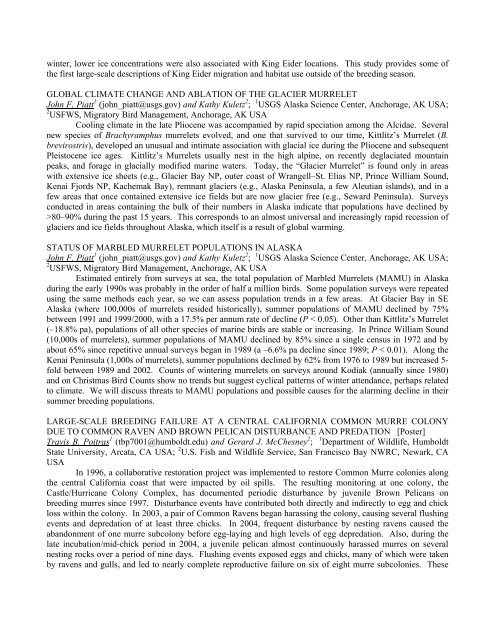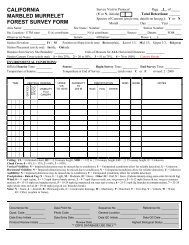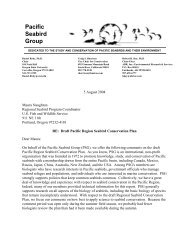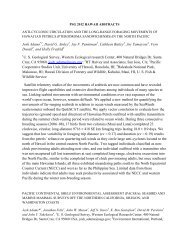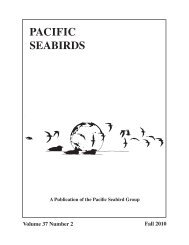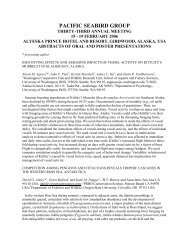abstracts of oral and poster presentations - Pacific Seabird Group
abstracts of oral and poster presentations - Pacific Seabird Group
abstracts of oral and poster presentations - Pacific Seabird Group
Create successful ePaper yourself
Turn your PDF publications into a flip-book with our unique Google optimized e-Paper software.
winter, lower ice concentrations were also associated with King Eider locations. This study provides some <strong>of</strong><br />
the first large-scale descriptions <strong>of</strong> King Eider migration <strong>and</strong> habitat use outside <strong>of</strong> the breeding season.<br />
GLOBAL CLIMATE CHANGE AND ABLATION OF THE GLACIER MURRELET<br />
John F. Piatt 1 (john_piatt@usgs.gov) <strong>and</strong> Kathy Kuletz 2 ; 1 USGS Alaska Science Center, Anchorage, AK USA;<br />
2 USFWS, Migratory Bird Management, Anchorage, AK USA<br />
Cooling climate in the late Pliocene was accompanied by rapid speciation among the Alcidae. Several<br />
new species <strong>of</strong> Brachyramphus murrelets evolved, <strong>and</strong> one that survived to our time, Kittlitz’s Murrelet (B.<br />
brevirostris), developed an unusual <strong>and</strong> intimate association with glacial ice during the Pliocene <strong>and</strong> subsequent<br />
Pleistocene ice ages. Kittlitz’s Murrelets usually nest in the high alpine, on recently deglaciated mountain<br />
peaks, <strong>and</strong> forage in glacially modified marine waters. Today, the “Glacier Murrelet” is found only in areas<br />
with extensive ice sheets (e.g., Glacier Bay NP, outer coast <strong>of</strong> Wrangell–St. Elias NP, Prince William Sound,<br />
Kenai Fjords NP, Kachemak Bay), remnant glaciers (e.g., Alaska Peninsula, a few Aleutian isl<strong>and</strong>s), <strong>and</strong> in a<br />
few areas that once contained extensive ice fields but are now glacier free (e.g., Seward Peninsula). Surveys<br />
conducted in areas containing the bulk <strong>of</strong> their numbers in Alaska indicate that populations have declined by<br />
>80–90% during the past 15 years. This corresponds to an almost universal <strong>and</strong> increasingly rapid recession <strong>of</strong><br />
glaciers <strong>and</strong> ice fields throughout Alaska, which itself is a result <strong>of</strong> global warming.<br />
STATUS OF MARBLED MURRELET POPULATIONS IN ALASKA<br />
John F. Piatt 1 (john_piatt@usgs.gov) <strong>and</strong> Kathy Kuletz 2 ; 1 USGS Alaska Science Center, Anchorage, AK USA;<br />
2 USFWS, Migratory Bird Management, Anchorage, AK USA<br />
Estimated entirely from surveys at sea, the total population <strong>of</strong> Marbled Murrelets (MAMU) in Alaska<br />
during the early 1990s was probably in the order <strong>of</strong> half a million birds. Some population surveys were repeated<br />
using the same methods each year, so we can assess population trends in a few areas. At Glacier Bay in SE<br />
Alaska (where 100,000s <strong>of</strong> murrelets resided historically), summer populations <strong>of</strong> MAMU declined by 75%<br />
between 1991 <strong>and</strong> 1999/2000, with a 17.5% per annum rate <strong>of</strong> decline (P < 0.05). Other than Kittlitz’s Murrelet<br />
(–18.8% pa), populations <strong>of</strong> all other species <strong>of</strong> marine birds are stable or increasing. In Prince William Sound<br />
(10,000s <strong>of</strong> murrelets), summer populations <strong>of</strong> MAMU declined by 85% since a single census in 1972 <strong>and</strong> by<br />
about 65% since repetitive annual surveys began in 1989 (a –6.6% pa decline since 1989; P < 0.01). Along the<br />
Kenai Peninsula (1,000s <strong>of</strong> murrelets), summer populations declined by 62% from 1976 to 1989 but increased 5-<br />
fold between 1989 <strong>and</strong> 2002. Counts <strong>of</strong> wintering murrelets on surveys around Kodiak (annually since 1980)<br />
<strong>and</strong> on Christmas Bird Counts show no trends but suggest cyclical patterns <strong>of</strong> winter attendance, perhaps related<br />
to climate. We will discuss threats to MAMU populations <strong>and</strong> possible causes for the alarming decline in their<br />
summer breeding populations.<br />
LARGE-SCALE BREEDING FAILURE AT A CENTRAL CALIFORNIA COMMON MURRE COLONY<br />
DUE TO COMMON RAVEN AND BROWN PELICAN DISTURBANCE AND PREDATION [Poster]<br />
Travis B. Poitras 1 (tbp7001@humboldt.edu) <strong>and</strong> Gerard J. McChesney 2 ; 1 Department <strong>of</strong> Wildlife, Humboldt<br />
State University, Arcata, CA USA; 2 U.S. Fish <strong>and</strong> Wildlife Service, San Francisco Bay NWRC, Newark, CA<br />
USA<br />
In 1996, a collaborative restoration project was implemented to restore Common Murre colonies along<br />
the central California coast that were impacted by oil spills. The resulting monitoring at one colony, the<br />
Castle/Hurricane Colony Complex, has documented periodic disturbance by juvenile Brown Pelicans on<br />
breeding murres since 1997. Disturbance events have contributed both directly <strong>and</strong> indirectly to egg <strong>and</strong> chick<br />
loss within the colony. In 2003, a pair <strong>of</strong> Common Ravens began harassing the colony, causing several flushing<br />
events <strong>and</strong> depredation <strong>of</strong> at least three chicks. In 2004, frequent disturbance by nesting ravens caused the<br />
ab<strong>and</strong>onment <strong>of</strong> one murre subcolony before egg-laying <strong>and</strong> high levels <strong>of</strong> egg depredation. Also, during the<br />
late incubation/mid-chick period in 2004, a juvenile pelican almost continuously harassed murres on several<br />
nesting rocks over a period <strong>of</strong> nine days. Flushing events exposed eggs <strong>and</strong> chicks, many <strong>of</strong> which were taken<br />
by ravens <strong>and</strong> gulls, <strong>and</strong> led to nearly complete reproductive failure on six <strong>of</strong> eight murre subcolonies. These


